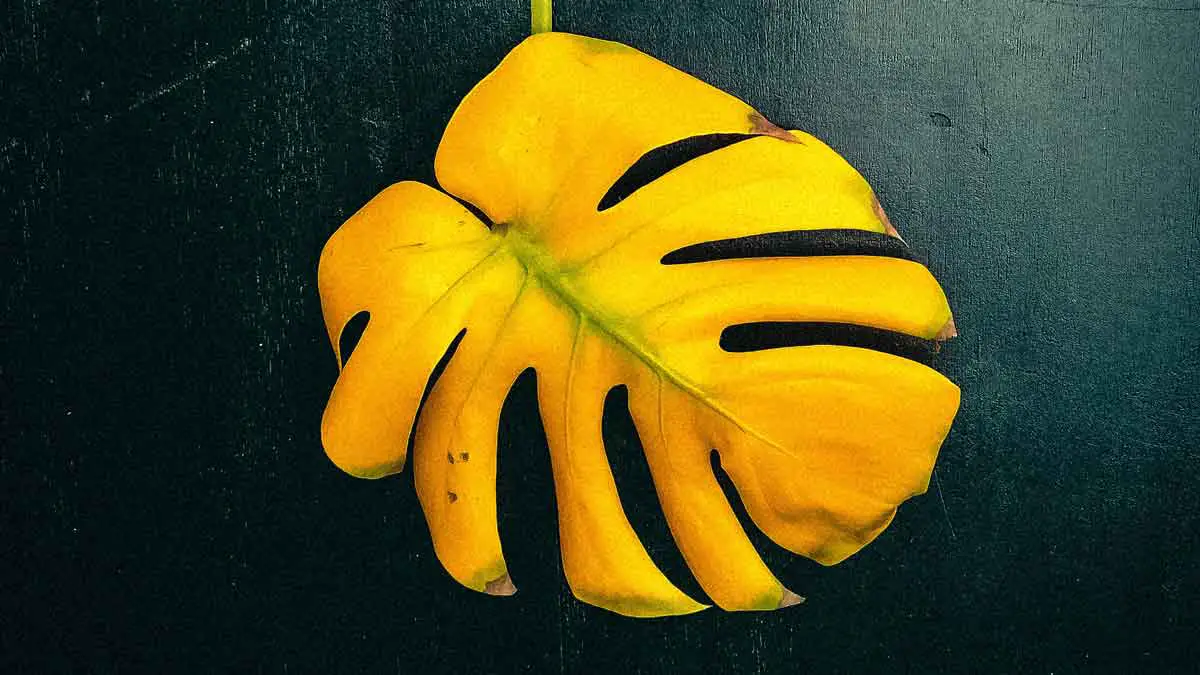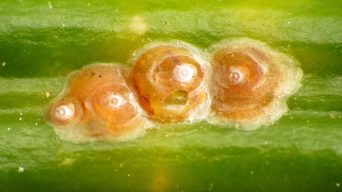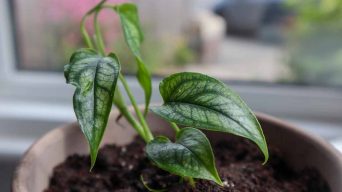To treat an overfertilized Monstera plant, leach the soil by thoroughly watering it until excess fertilizer is flushed out. Signs of overfertilization include stunted growth, burned leaves, wilting, and plant death. Avoid overfertilizing in the future to prevent damage to roots and leaves.
Have you ever been so excited about caring for your Monstera plant that you overfertilized it?
If so, don’t worry – you’re not alone! Overfertilizing is a common mistake among enthusiastic gardeners.
Fortunately, with a little knowledge and the right approach, it’s possible to treat and prevent damage caused by overfertilization.
Here we’ll discuss exactly what happens when you overfertilize a Monstera and how to get your beloved plant back on track. So if you’ve made this error in judgment before, keep reading – there’s hope yet for your Monstera!
How Does Overfertilization of Monstera Plants Occur?
The Monstera, the Swiss Cheese plant, is a popular houseplant known for its large, glossy leaves and easy care requirements.
But like any plant, they can be susceptible to overfertilization if not correctly cared for. Overfertilization occurs when too much fertilizer is applied to the soil, resulting in excess nutrients that can damage or even kill the plant.
The most common cause of overfertilization is applying too much fertilizer at once. This can happen if you use a fertilizer with a high concentration of nutrients or if you apply it more frequently than recommended.
It can also occur if you use a fertilizer that contains too many different types of nutrients, such as nitrogen, phosphorus, and potassium.
Another cause of overfertilization is using the wrong type of fertilizer for your Monstera.
Different plants require different types of fertilizers to meet their specific needs; using the wrong one can lead to an imbalance in the soil that can cause overfertilization.
For example, monsteras prefer slow release fertilizers that provide steady nutrition over time rather than quick-release fertilizers that give an immediate boost but quickly dissipate.
Overfertilizing your Monstera is a severe problem that should be addressed immediately; otherwise, it could result in permanent damage or even death for your beloved houseplant!
Signs of Overfertilized Monstera Plants
When caring for your Monstera, one of the most important things to be aware of is overfertilization.
Too much fertilizer can cause problems for your plant, from stunted growth and wilting to brown spots on Monstera leaves and even death.
Knowing the signs of overfertilization can help you take action quickly and save your beloved Monstera.
Stunted Growth
Stunted growth is one of the most common signs that you’ve overfertilized your Monstera.
If you’ve been fertilizing your plant regularly, but it isn’t growing as quickly as it should be, it could be a sign that you’re giving it too much fertilizer.
Burned or Dried Leaf Margins
Another sign that you may have overfertilized your Monstera is burned or dried leaf margins.
This happens when too much fertilizer accumulates in the soil and causes burning around the edges of the leaves.
The Monstera leaves will look dry and discolored and may curl up or become brittle.
Wilting
Wilting is another common symptom of overfertilization in Monsteras.
If your plant is wilting despite regular watering, it could be a sign that there’s too much fertilizer in the soil.
Wilting can also occur if there isn’t enough water in the soil, so check both before taking action.
Collapse or Death of Plants
In extreme cases, overfertilizing can lead to plant collapse or even death. This usually happens when the plant is exposed to high fertilizer levels for an extended period.
If you notice any sudden changes in your Monstera, such as wilting or yellowing leaves, this could be a sign that you’ve given it too much fertilizer and need to take action quickly to save it.
Brown or Black Roots
If you notice brown or black roots on your Monstera, this could be a sign that you’ve been overfertilizing it.
When too much fertilizer accumulates in the soil, it can cause root burn, turning them brown or black and making them brittle and weak. This can prevent your Monstera from absorbing the nutrients it needs, causing growth problems.
Distorted Leaf Shape
Another symptom of overfertilization is the distorted leaf shape.
If your Monstera’s leaves are curling up at the edges or becoming distorted in some way, then this could be a sign that there’s too much fertilizer in the soil, causing an imbalance in nutrients for the plant.
The leaves will also look discolored and unhealthy.
Brown Spots on Leaves
Finally, brown spots on leaves can also indicate that you’ve been overfertilizing your Monstera.
These spots are usually caused by an accumulation of salts from too much fertilizer, which will cause burning on the leaves and eventually lead to their death if not treated quickly enough.
The spots can range in size and shape and will usually start at the tips of the leaves before spreading throughout.
How To Treat Overfertilized Monstera Plants
You can use several remedies to treat your overfertilized Monstera plant so it can go back to its best state.
Leaching the Soil
The first step in treating an overfertilized Monstera plant is leaching the soil.
This process consists of two steps: watering the plant thoroughly and flushing out excess fertilizer.
When it comes to watering your Monster Plant, make sure that you give it enough water so that it penetrates down into the roots.
Once the soil has been thoroughly soaked with water, allow any excess moisture to drain away to ensure all of the fertilizer has been removed from its root system.
Afterward, you may need to flush out any additional fertilizer by running water through the pot several times until it runs clear from the bottom of the container.
Make sure you discard this used water and do not reuse it on other plants. Most fertilizer salts can be damaging when left in full concentrations in soil or water runoff.
Rinsing Off The Roots And Repotting In Fresh Soil
Next, use clean lukewarm water (not hot) to rinse off any remaining fertilizers on your Monstera plant’s roots.
Gently shower them with a spray bottle or kitchen sink sprayer head for about 10 minutes until they are free from visible salt deposits or buildup along their spines or near their leaf nodes. Carefully remove your Monstera from its current soil mixture and repot it into a fresh sterile potting mix. Make sure the potting soil is low in organic matter and free from any pre-mixed fertilizers or added nutrient supplements like compost tea or fish emulsions.
This will also help prevent overfertilizing issues in future feedings, which should always be avoided!
Once potted in fresh soil, continue caring for your Monster Plant as usual.
However, keep an eye out for signs of distress, such as wilting leaves – if these occur, simply reduce the watering frequency until a healthy balance is achieved again.
This often takes only about 2 weeks after repotting, depending on the climate conditions where you live.
Pruning Damaged Leaves And Stems
Once all excess fertilizers have been flushed out through either leeching methods described above, start pruning away any damaged leaves or stems caused by overfertilization.
Anything yellowed or deflated should be cut back immediately, so only healthy green foliage remains on each branch segment.
Pruning your Monstera will help reduce stress levels significantly while also encouraging new growth!
Using A Soil Amendment Like Activated Charcoal
For extra protection against future overfertilization issues, add some activated charcoal (also known as activated carbon) into your Monster Plant’s new soil mix before repotting.
This substance helps absorb nutrients like nitrogen which tend to accumulate excessively when applying too much fertilizer– thus making it harder for these compounds to build up within future feeding cycles!
Furthermore, activated charcoal also acts as a natural pH buffer helping maintain optimal growing environments inside containers where humidity levels fluctuate.
Overall this is great for keeping indoor houseplants lush throughout their life, regardless of size.
How to Avoid Overfertilizing Your Monstera Plant
Prevention is the best cure for taking care of your Monster Plant.
There are several things you can do to avoid overfertilizing your plant.
Choosing the Right Fertilizer
The first step in avoiding overfertilization is choosing the right fertilizer.
There are two main factors to consider when selecting a fertilizer: N-P-K ratios and organic vs. synthetic fertilizers.
Understanding N-P-K Ratios
N-P-K stands for nitrogen (N), phosphorus (P), and potassium (K).
These three elements are essential nutrients for healthy plant growth, so selecting a fertilizer with an appropriate ratio is critical.
The ideal ratio for Monsteras is 3-1-2 or 5-2-3; however, other ratios, such as 1-1-1 or 2-4-2, will also work well.
Using Organic vs. Synthetic Fertilizers
Organic fertilizers come from natural sources like compost or manure, while synthetic fertilizers are made from chemicals in a lab.
Both types of fertilizer can provide excellent results; however, organic fertilizers tend to be more gentle on plants than synthetic ones since they release their nutrients more slowly over time.
For this reason, many gardeners prefer organic fertilizers when caring for their Monsteras.
Following Proper Fertilizing Techniques
Once you’ve chosen the right fertilizer, following proper fertilizing techniques is important to avoid overfertilization.
This includes using the right amount of fertilizer and applying it at the right time.
Using the Right Amount of Fertilizer
Measuring your fertilizer correctly is important to avoid giving your Monstera too much food at once.
Most liquid fertilizers come with instructions on how much should be used per gallon of water. However, if you’re using solid fertilizer, you’ll need to measure the appropriate amount with a kitchen scale or measuring spoon before adding it to your soil mix or watering can.
It’s also important not to overdo it – if you notice any signs of nutrient burn on your plant, stop fertilizing until those symptoms have cleared up before resuming regular feeding.
Applying Fertilizer at the Right Time
In addition to using the correct amount of fertilizer, it’s also important to apply it at the right time for your Monstera plant to get the maximum benefit from its food without becoming overwhelmed by too much nutrition all at once.
Seasonal changes in temperature and light levels can affect how often you should feed your plant.
When growth slows down in winter, reduce feedings slightly compared with summer months when growth speeds up. The growing season for Monstera plants is typically from late spring to early fall, and it’s best to fertilize your plant every two weeks.
As well as environmental factors like humidity levels can affect how quickly your plant’s roots absorb nutrients.
Adjusting your feeding schedule accordingly will help ensure that your Monstera gets just enough food without being overloaded with too much nutrition all at once.
Common Mistakes When Fertilizing Monstera Plants
To properly fertilize your Monstera plant, you must do more than avoid overfertilization; there are a few common mistakes to remember.
Underfertilization
Underfertilization is another common mistake people make when fertilizing their Monstera plants.
Not providing enough nutrients can lead to slow growth and weak stems, which can eventually cause your plant to die if left untreated.
To avoid this issue, using the right amount of fertilizer for your particular type of Monstera plant and providing regular feedings throughout its growing season (usually spring through fall) is vital.
It’s also important to note that different types of Monsteras require different amounts of fertilizer, so be sure to research what type of fertilizer is best for your particular species before applying it to your plant.
Applying Fertilizer at the Wrong Time
Applying fertilizer at the wrong time can also be detrimental to your Monstera’s health as it can cause root burn or other issues if done incorrectly.
Generally speaking, it’s best practice not to apply any fertilizer during a dormant period (usually winter), as this could damage or even kill your plant if done incorrectly.
Additionally, some types of fertilizers should only be applied during certain times, such as after repotting or when new leaves emerge from the stem. Be sure to research what type you are using before applying it to get optimal results with minimal risk involved.
Using the Wrong Type Of Fertilizer
Using the wrong type of fertilizer for your particular Monstera can also lead to poor results or even death if done incorrectly.
For example, some Monsteras prefer liquid fertilizers. In contrast, others prefer granular or powder-based ones, so be sure to choose accordingly, depending on what type you have.
Additionally, it’s important to read labels carefully when purchasing fertilizer to make sure that they contain the right amount of nutrients for your particular species of Monstera.
Each type of fertilizer will have a different nutrient profile, so choosing the one that best suits your plant’s needs is important.
Final Thoughts
Fertilizing your Monstera plant correctly is essential for its overall health and growth.
Too much fertilizer can damage your Monstera, so it’s important only to fertilize when needed and according to package instructions.
It’s also essential to ensure that the soil your Monstera is planted in has adequate drainage, as this can help to prevent overfertilization.
These steps will help you keep your Monstera healthy and thriving for years.







